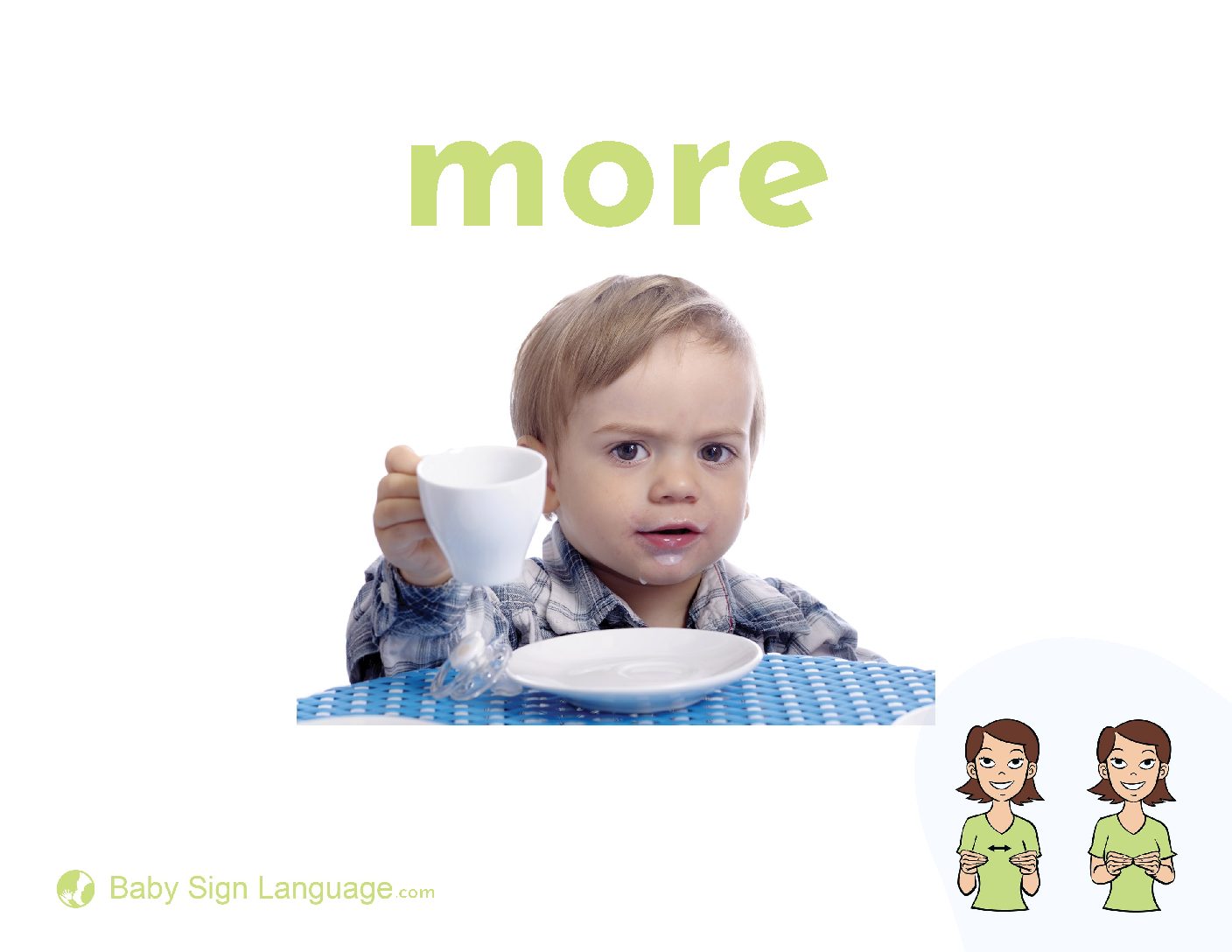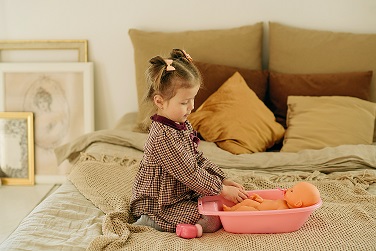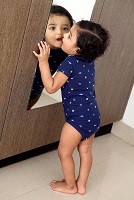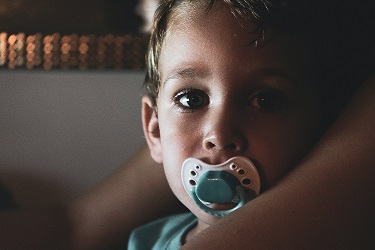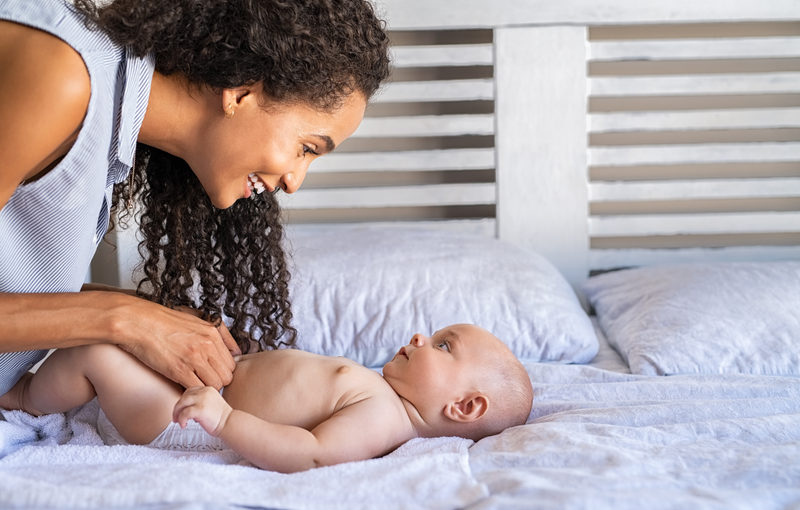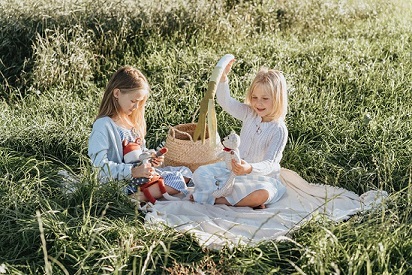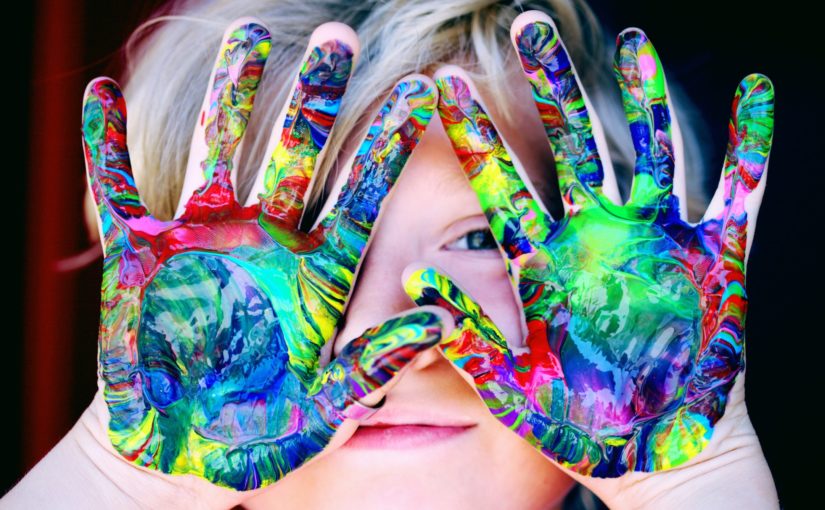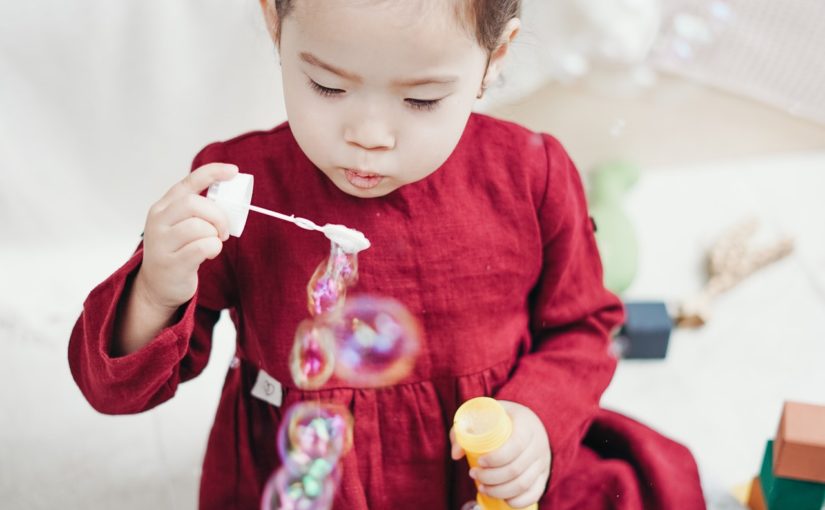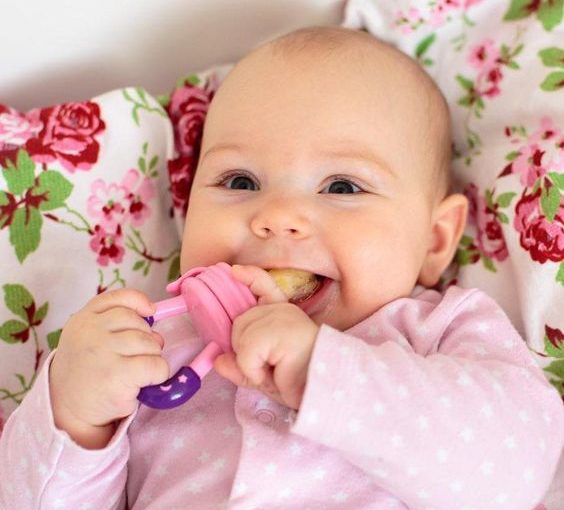TAKING CARE OF BABY
Whether it’s a baby doll or your baby’s favorite stuffed animal, pretending to take care of it can be a great way to teach speech and language skills. As I have stated in previous posts, pretend play is important for many developmental skills. It also can give your child a sense of playing an important role within the family. It’s a great way to prepare your kiddo for becoming a big brother/sister!
Before the age of 2, you will see your child engaging in some independent pretend play. They may begin to imitate some everyday routines they see parents/caregivers doing, such as wiping up the table or try on their highchair or booster seat. Similarly, they may pretend to feed dolls or stuffed animals, wash them, change their diaper, or dress/undress them. Much the same as these consistent routines YOU are helping them with! If you do not see your child engaging in this type of play, you can demonstrate it for them. If they are playing in their play kitchen, show them to pretend to give the doll or stuffed animal a drink. Model sounds/words/word combinations to “talk” for the toy. For example, “Milk please.”, “Thank you.”, make a sipping sound, then “ahhhhh” or “mmmm, yummy!”. Pretend to give the doll or stuffed animal a bath and narrate what you are doing. “Time to get a bath!”, “Wash, wash, wash”, or talk about what you’re washing to work on labeling body parts. For example, “Wash toes!”, etc. Then you can incorporate transitioning the baby from getting a bath to getting dry and dressed. You can model “We need a towel”, “Dry, dry, dry”, then “All done!”, “Pajamas on”, “Feet in”, “Arms in”, etc. In addition, you can expand this further to a bed time routine and they can help you put the baby to bed. Model “Night-night baby” and give your child directions to “Give the baby a blanket” or “Give baby a kiss”, etc(then make the kissing sound).
These activities can help build your child’s vocabulary, ability to make sounds, and turn taking skills with you. It may even help with some of these routines if they give you a hard time getting through it without a meltdown. Pretending to take care of a favorite toy builds their speech and language development, pretend play skills, social skills, and so much more!
Sounds/words to include: baby, eat, sit, drink, wash, water, milk, juice, names of foods, soap, bubbles, pop, body parts, names of clothing, night-night, all clean, all done, on, off, be, blanket, shhhhh, ahhhhhh, mmmmmmm, yum/yummy, etc.
MIRROR PLAY
Have you ever walked into a child care and notice mirrors on the walls? In some infant or young toddler rooms, they are placed at ground level. Why is this? As infants, it is important for babies to see their own reflections, as well as, the reflections of those that care for them. This is a great way to teach them they have a name and so do the other people around them(Hi Joey, Hi Daddy – as you wave). It is also helpful for them to see their actions, giving them the visual feedback as their movements are giving them proprioceptive and vestibular feedback.
Mirrors can be helpful to begin teaching body part identification, for both themselves and on other people(Joey’s nose, Mommy’s nose). Also, it’s a fun way to give them awareness of how their mouth moves and sounds they can make.
For those children that are delayed in their speech and language skills, this can be helpful. However, some may avoid looking in the mirror and resist when it’s introduced. In my experience, these are the kiddos that also resist imitation for a long time. Anecdotally, there seems to be a connection in their perception of potentially failing at the task. They avoid at all costs until they feel confident that the attempt will be a perfect imitation.
If you have a child that does not enjoy looking in the mirror and making silly faces, try setting up a mirror where he/she plays the most. They may end up watching themselves play periodically, learning about how their bodies move. This could aid in less resistance to watching themselves, and you in the mirror. Once they realize watching themselves move their bodies(including their mouths)can help them to imitate more accurately, you can begin to teach them new sounds and words. Have fun and provide a lot of reinforcement as they try new things outside of their comfort zone!
PACIFIERS AND SPEECH DEVELOPMENT
One of the most common questions I get as an Early Intervention Speech Pathologist is about pacifier use. Pacifiers certainly have their use for our babes. Not just to help soothe those fussy babies! It has been linked with decreased risk of Sudden Infant Death Syndrome(SIDS) and can help babies learn to self soothe. Some studies have shown pacifiers can be helpful for babies who may have trouble sucking or have an underdeveloped sucking reflex. Sucking is a reflex for newborn babies. Newborn reflexes do disappear as babies grow. We should see our babies decrease their need for sucking. They grow and take the bottle or breast less frequently. They begin to eat purees and transition to cup drinking(which I will have more information on).
There is much debate when your baby should no longer have the pacifier. In my experience, “cold turkey” may be more trouble than it’s worth. If it can be slowly decreased, it will be easier(for everyone!) when it suddenly “disappears”. Once your baby begins to show joint attention and imitation, he/she should begin to have it less often during the day. They can begin to explore how their mouths move and all the sounds they can make using toys, teethers, and even foods as they begin venturing through the feeding stages. As they get older, their awareness and memory begin to grow as well. Strategies to decrease pacifier use when they are in toddler stages will be more difficult because of this. In addition, the longer they use the pacifier, the structure of their mouth will begin to be affected and dentition shape will impact speech production.
If you have found yourself with a toddler attached to their pacifier, there are a few things to try to replace the soothing comfort it has provided them. Some children do truly have an oral sensory need for more input to help them feel regulated. Currently, Occupational Therapists(OT) and Speech Language Pathologists(SLP) are recommending use of straw cups over sippy cups. There are many reasons for this shift. One of them being the input your child receives with sucking liquids through a straw. If your child seeks oral input, a straw to drink form is a great alternative and provides regulation to the sensory system. In addition, there are many tools that can be a good substitute throughout the day when they are looking for something to chew on or put in their mouth. When they are teething, these tools can serve double duty! Some of these can also be used to assist with feeding difficulties. It is important to always seek the assistance of a professional pediatric OT or SLP in this case. Contact your pediatrician to inquire about your local Early Intervention program. This is a process. It may happen more slowly than you would like, but it CAN happen with a plan. Please see link below for more information if you would like to explore some alternatives to decrease pacifier use.
DIAPER CHANGES
Not always the most pleasant routine of the day, but diaper changes can be a great learning opportunity for your baby! During this time, you are usually face to face. This gives your baby the perfect view of your mouth. As your baby watches you move your mouth, and hears the sounds/words you make, they will begin to imitate(as long as hearing is in tact). Not only are they imitating the motor actions of your mouth, but their tiny brains will make new connections, and the output will be imitation of sounds! So, as many times as you change diapers all day, will be the number of times you are teaching them speech and language!
This is a great time to make silly faces and sounds(raspberries, ooooh, ahhhh, etc). Talk about what you are doing(up, lay down, pants off, wipe, all clean, socks!, etc). Sing songs to your baby and gain eye contact with them. So many ways to engage with them and teach them during this routine! As they get older and begin to wiggle, protesting the process, any of these strategies can work to distract them from their protest.
Diaper changes can be a perfect time to gain interest and increase imitation for those kiddos who are not imitating or using sounds and words. Watching your mouth as they listen can be helpful to their ability to imitate. See developmental milestones in the resources tab for more information regarding when and what you should expect.
*If you have concerns that your baby is not reaching speech and language milestones, speak to your pediatrician or reach out to your local Early Intervention program.
Sounds/words to include: diaper, shirt, pants, socks, up, down, on, off, ooooh, yuck, stinky, wet, dry, all clean, all done, eye, nose, mouth, ears, head, arms, legs, feet, make “raspberries”, pop lips, click tongue, make any silly sound
PICNIC
Many children go through a phase that they begin to feed their dolls, stuffed animals, or their family members. This a BIG milestone for play development. It can also be a great way to learn language! Join in with them to help create a picnic inside…or out! Those of us living in cold weather the next few months, we can turn any space inside into a picnic. Your children can bring along their favorite dolls or stuffed animals. Help them pack a “picnic basket” by asking them to find certain foods/drinks you would like(or pretend one the dolls wants). Also, when the kiddos choose what they want, help them name the food or drink before putting it in the basket. While setting everything up, talk about everything else you need for the picnic and describe what you are doing. Ask your children to help! Everyone will need a plate, cup, fork, spoon, etc. Model the language you would like them to use. For example, “May I have some grapes?”, “Thank you!”. You can use their pretend food or what you have in your kitchen. The kids will have fun hearing you pretend to talk in funny voices for their friends(dolls or stuffed animals). They may even begin doing it as well! Modeling words and phrases during pretend play helps them learn and build their language skills, social skills, and maybe even some motor skills too! If your child(ren) prefer a tea party, make it a tea party! For some of our “picky eaters”, this may help them to try new foods! Picnics, real or pretend, are a great way to help children learn new words and how to use them!
Sounds/words to include: names of foods and drinks, names of dolls or stuffed animals, blanket, basket, plates, cups, fork, spoon, napkin, pour, scoop, pass, more, please, all done, yum, yuck, yes, no, thank you, your welcome, etc.
BABY SOUNDS
What are the first sounds babies begin to use? You will hear their first cooing/gurgling sounds around 6-8 weeks. These sounds typically occur at the back of the mouth so think “ga-ga-ga” sounds. When they begin babbling between 6-9 months you will likely here “Mamama”, “Bababa”, or “Dadada”. It’s when you begin to respond to these babbles they begin to attach meaning that “Mamama” goes with “Mama” or “Dadada” goes with “Dada”. As you model “Mama” and get very excited, the babbles shorten in length. They figure out that, when I do this with my mouth and make these sounds only twice, that important lady who always takes care of me, responds to me and gets very happy😊 These sounds can be important indicators on what’s to come next. Your interactions and responses play an important part with more sounds and words that happen over the next year.
What’s an easy, fun way to help this continue to expand? Animal sounds, environmental sounds, and exclamatory sounds. What does that include? Glad you asked! Ask yourself what animals do you and your baby see regularly. In your house, around your neighborhood, looking at books, playing with their toys, etc. Model when you see them, “Moooo says cow”, “Woof-woof says dog”(or insert your own dog’s name), “Tweet-tweet says bird”. You get the picture.
What are environmental sounds? “Vroom-vroom goes the car”, “Beep-beep says the bus”, “Choo choo says the train”, and so on.
Exclamatory sounds you ask? “Ta-da!” Here they are(hope you caught that example right there!): “Boom”, “Uh-oh”, “Plop”, “Wheee!”, “Whoa!”, “Wow!”, “Zoom”, “Mmmmmm!”, “Ahhhhh”. You can model these sounds as soon as your baby begins to smile at you(6-8 weeks) as you begin bonding through daily interactions-feeding, diaper changes, and play. Follow their lead sometimes too! Imitate the sounds they make and see how long they will keep the exchange up. This is the beginning of the natural pauses in conversation and learning about turn-taking!
SENSORY PLAY
What is sensory play or sensory-motor play? Play that engages your sensory system(thing the 5 senses) along with two more senses few people know about that involve movement and balance/body awareness(vestibular and proprioceptive). Stay tuned, and I will explain how you can use these activities to boost speech and language development. As your baby grows into a very busy, curious toddler, it is important to provide them with a variety of “sensory” type activities. You may not even realize how many you are already doing, or how they are exploring and learning how to manage all the sensory input their bodies and brains are craving. For more information, visit www.yourkidstable.com.
Why is it important? Children learn best while engaged and motivated. They are already gaining so many skills so quickly in the first years of their lives. Engaging all systems during daily routines and activities provides optimum learning experiences for development. Providing these activities and engaging with them will help develop motor skills for future athletes or writers, language skills for future public speakers(#teachersareessentialworkers), and social skills for future community leaders. You can find a ton of creative ideas on the internet using everyday household items and daily routines to create these experiences.
Some children need more sensory activities than others. These are great opportunities to teach new sounds and words! Also, it will be more motivating to use that sound/word to request a continuation of the activity😊 Below are some ideas to help get those sounds and words out for the “quiet players”:
Messy play– finger painting(paint or foods like whip cream), play dough, sandbox, bin of rice/noodles/water. Words/sounds to include: wheee!, zoom, dot-dot-dot, smash, roll, push, pull, bounce, ball, snake—ssss, cookie, yum, yucky(ooooo), scoop, dig, dump
Bouncing/rolling on a ball- make sure it’s a large enough ball that they need a little help staying on it. Words/sounds to include: bounce, roll, up, down, more, all done, sing songs while they are on it(Row, Row, Row Your Boat, Wheels on the Bus, ABCs)
Swinging– on the playground, in your arms, or in a blanket(safely with two people holding the blanket). Words/sounds to include: swing, wheee!, up, down, more, all done, Ready-Set-Go, 1, 2, 3, Go
Jumping/Hopping– you can pretty much do this anywhere! Words/sounds to include: jump, hop, boom, up, down, more, all done, Ready-Set-Go, 1, 2, 3, Go
There are so many more activities out there that are examples of sensory play! If you have questions or concerns, feel free to message me. Always remember to speak to your pediatrician about your local Early Intervention program.
BUBBLES, BUBBLES, BUBBLES!
Why are bubbles such an important toy for early learning? Besides being fun and motivating for young(and even older) children, it’s a simple way to engage them with you! When they are actively engaged in watching them form and float, they will then move to try to touch them. You can model action words such as, “Pop!” or “Blow!”, and descriptive words such as “Big!” or “Little”. Your child will want more to continue this activity, so you can wait for them to ask for “more” or ask them if they want “more”. This will give them an opening to respond by imitating “more” or respond “yes” or “no”(verbally or non-verbally). As they get older and more mobile, you can give them directions to “stomp”, “clap”, “kick”, or “poke” the bubble to pop it. Also, you can teach them to blow bubbles which is important to build awareness of their mouths and what each part(cheeks, lips, tongue, jaw) has to do to successfully blow bubbles. If they aren’t able to round their lips to blow through a wand, you can find bubble blowers on line or at a local toy store that they dip one end in the bubbles and blow through the other. They will be so proud of themselves when they blow their own bubbles AND have a blast taking turns with you to see who can blow the biggest bubble!
Sounds/words to include: bubble, blow, pop, kick, stomp, clap, poke, big, little, more, all gone, oooo, wow, me, my turn, etc.
FEEDING BABY
Around the same time babies begin to teethe, they begin to their first foods. Also, they begin to make more sounds. Feeding and speech development are closely related! They compliment each other and each milestone your baby meets in one area, s/he should meet another milestone in the other area. Once your baby shows interest in putting objects in their mouths, you can present them opportunities to explore tastes and textures of the foods you eat. You can do this safely with the use of baby food feeders(mesh or silicone)that are found in the baby section of many stores, or on line by searching for “baby safe feeders”. Starting with vegetables and fruits that your baby has already shown no allergy or sensitivity to can give them new tastes and textures to explore, while helping them learn to move their tongue, lips, and jaw in a variety of directions to develop the coordination needed for emerging speech sounds. You will begin to hear them makes sounds while they are exploring that you can imitate back to them, creating a socially enjoyable experience and connection with you as their feeder. Imitation of the actions occurring in their mouths while feeding is as important as the imitation of sounds that naturally occur as they move their mouths. Your baby will learn the difference of the sounds they can make while their lips are closed(mmmmm) or when their mouths are open with their tongues down(gagaga). Giving your baby early experiences with a variety of tastes and textures could lead to decreased protest of new tastes and textures as they grow. In addition to these feeders giving your baby opportunities to explore new foods, it can be useful for those painful teeth coming in! Place fruits or veggies in the freezer and place them in the feeder for some tasty relief😉. You will also be teaching your child about different temperatures of foods this way! Always consult with your pediatrician or early interventionist when moving from purees to solids, even if presented in a safe way with the use of these feeders.
